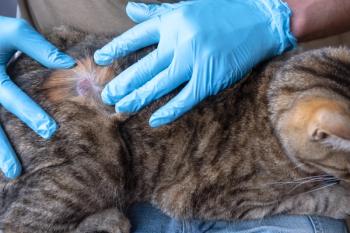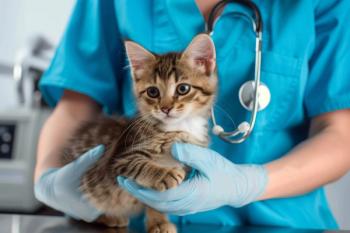
The incredible shrinking client base
Gerald Snyder, VMD, provides an analysis on client visits and the changing times.
Blackjack is a simple game, I'm told by friends and colleagues who frequent Las Vegas.
Learn the basic tables that tell you when to hold or hit in the exact same way your elementary school teacher drummed the times table into your much-smaller noggin, and it's unlikely you'll ever leave a casino having handed over your car keys to a large stranger in dark glasses.
The times table will never change, but the times certainly will.
Some readers may remember seminars I gave as far back as 1994, when I quoted economist Harry S. Dent as saying, "Make hay until 2008 because that's when the worm turns." He didn't say exactly that, but that's how my twisted mind remembers it.
We de-worm our patients on a 14- to 21-day interval simply because we know that will end the lives of parasite "wannabes" among the youngsters in the cycle of worm maturity.
Well, in the same way, it takes 46 years for babies born at the height of the Baby Boom to achieve their greatest earning power, making the greatest impact on our economy.
What happened after 1956, the peak of the Baby Boom, is that the Boomers stopped booming each other and fewer and fewer babies were begat. The birth rate 10 years later was down 20 percent, and 15 years later it was down 25 percent.
Add 46 years to 1956 to see what is now hitting us. In 2002, the biggest wave of grown-up babies were spending the most dollars in our history. Unfortunately, they spent a huge amount on dot-com investments and wound up with very little to show for it.
Six years later finds us in 2008. That's when mature earners dropped by about 10 percent on the way to 25 percent fewer babies per annum. You can't make fig bars without figs, and you can't have pet owners without humans.
If your client transaction numbers are down 10 percent or more from 2002, you now know why.
The quintupling of the cost of wheat and doubling of the cost of gasoline have lightened the purses of many, but there is no mistaking the fact that there simply are fewer earners out there.
Some will tell you the population decline is being made up by the rapid influx of immigration over the last quarter century. They are correct up to a point, but it's a hazardous point. Immigrants, by and large, produce more children, but pet ownership in most cases is not a big part of their culture. Further, the vast majority earn very low incomes.
So, what is the future of veterinary medicine?
I foresee a constriction in the need for our services, causing premature closure of some 15 percent (mostly guesswork) of today's practices, stemming from a combination of lack of productive management and/or simply demographic inopportunity.
If you are in a negative-growth area with migrations away from your practice, you have little choice but to migrate with the population or shrink your number of practitioners, staff and expectations.
Consolidation of practices by corporate entities will grow because sectors of multiple failing practices can be merged into a single facility with much less overhead.
Practice owners could do this themselves, but, given our extreme individualism, many would rather fail than combine with that competing practice down the road.
Is your ATF high enough?
For most, failure is due to subsidizing clients with fees lower than needed to sustain the practice as profitable. This leads to unsellable practices at a time when real-estate values are certainly less than peak in most areas of the country.
It is not the number of transactions that counts, but the quality of each transaction. To have 5,000 transactions per veterinarian is nice, but 4,000 will do if your average transaction is 20 percent to 25 percent greater.
Most practices should track average transactions by year. Too often the Average Transaction Fee (ATF) is just 20 percent higher than it was five years ago, when by inflation alone it should be 40 percent to 50 percent higher.
Affordable ATF is a function of the demographics. I see too many practices at 50 percent to 60 percent of the ATF their local clients can afford, when 90 percent to 100 percent would feed the practice and its staff much more comfortably.
Subsidizing clients is the most common disease in veterinary medicine. It is fueled by irrational guilt.
A busy practice with low profits is like eating soup with a fork. You are fully occupied running your practice, but you're still hungry.
Now is the time for all good vets to come to their own practice's aid. If you are not able to bonus your staff based on increased production over prior years, you are likely to fail in future years.
Is your ATF close to three times your examination fee? If not, is your examination fee too high and driving away potential clients, or is it just that your service fees have not kept up with the almost 10 percent yearly inflation for veterinary practices?
Which of your clients will step up to support you when you have to close your doors?
What will your trained staff do when you have to close because your management wasn't managing at all?
Will you be stuck paying a mortgage on a building you can't get enough clients to justify?
This is the time to ask yourself some tough questions.
I really don't want to see you finding something you don't want behind Door No. 2009.
Dr. Snyder, a well-known consultant, publishes Veterinary Productivity, a newsletter for practice productivity. He can be reached at 112 Harmon Cove Towers Secaucus, NJ 07094; (800) 292-7995;
Newsletter
From exam room tips to practice management insights, get trusted veterinary news delivered straight to your inbox—subscribe to dvm360.




